Farewell Yutu – artistic impression of Earthrise over Yutu at lunar landing site. This composite timelapse photomosaic combines farewell view of China’s Yutu rover with Moon’s surface terrain at Mare Imbrium landing site and enlarged photo of Earth – all actual images taken by Chang’e-3 lander. Not a science image. Credit: CNSA/Chinanews/Ken Kremer/Marco Di Lorenzo – kenkremer.com
See complete Yutu timelapse panorama below and at NASA APOD Feb. 3, 2014:http://apod.nasa.gov/apod/ap140203.html
Story and Headline revised and updated[/caption]
Update: There might yet be hope for Yutu. Amateur radio operators at UHF-satcom reported detection of a signal from Yutu today. But no update has been reported on the China News Service website or other official state media. Yutu’s fate is unknown.]
Update 2: Yutu is alive. story and headline revised. Further details – here
………..
For a time, it seemed China’s maiden moon rover ‘Yutu’, beloved by millions worldwide, had been lost.
The apparently unfortunate and sad breaking news was just reported today in an ultra brief dispatch by the English language version of Chinadaily – with the headline “Loss of lunar rover.”
But the death notice by Chinese officials turned out to be premature when a signal was detected a day later.
It had been thought that Yutu froze to death due to a pre-hibernation mechanical malfunction and failed to wake up and communicate with China’s mission controllers in Beijing on Monday, Feb. 10, when daylight returned to the rovers Moon landing site at Mare Imbrium (Sea of Rains) at the start of what would have been Lunar Day 3 for the mission.
“China’s first lunar rover, Yutu, could not be restored to full function on Monday [Feb. 10] as expected,” wrote the state owned Chinadaily.com, China News Service agency.
The cause of the pre-hibernation malfunction may perhaps be traced back to a buildup of abrasive lunar dust, but no one knows at this time.
Note: This story has been updated as further details emerged.
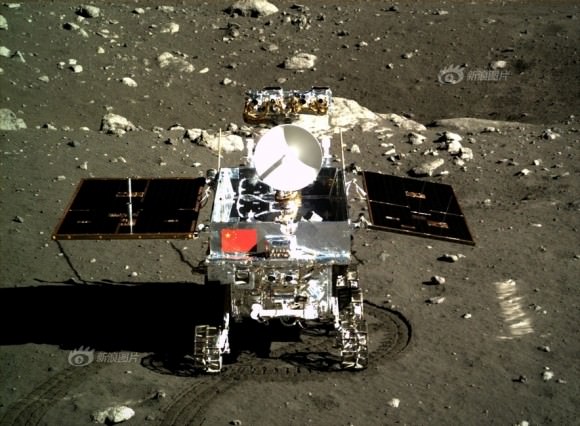
Yutu has touched the hearts of countless Earthlings since the history making landing on the desolate gray plains of the the Moon atop the Chang’e-3 lander two month ago on Dec. 14, 2013.
See our timelapse mosaic, artistic impression of Earthrise over Yutu – above – by the image processing team of Ken Kremer and Marco Di Lorenzo.
It combines real images of the Moon’s surface terrain with an intentionally enlarged photo of Earth – all snapped by the Chang’e-3 lander – as a homage to the mission.
See the complete timelapse mosaic herein and featured at NASA APOD on Feb 3, 2013.
Although definitive word about the Chang’e-3 lander has not yet been announced, it is expected to survive and has a 1 year design lifetime.
Potentially bad news about Yutu’s fate was not unexpected however, after Chinese space officials disclosed that the rover “experienced a mechanical control abnormality” two weeks ago, just as her 2nd lunar night was to begin, according to a report by China’s official government newspaper, The People’s Daily.
“Yutu experienced mechanical problems on Jan 25 and has been unable to function since then,” according to Chinadaily.com, China News service.

This 360-degree time-lapse color panorama from China’s Chang’e-3 lander shows the Yutu rover at three different positions during its trek over the Moon’s surface at its landing site from Dec. 15-22, 2013 during the 1st Lunar Day.
Credit: CNSA/Chinanews/Ken Kremer/Marco Di Lorenzo – kenkremer.com
See our Yutu timelapse pano also at NASA APOD Feb. 3, 2014:
http://apod.nasa.gov/apod/ap140203.html
Each lunar day and night lasts for alternating periods of 14 Earth days.
The six wheeled Yutu rover and Chang’e-3 mothership lander had just finished sleeping through the terribly frigid two week long lunar night since they entered their second hibernation period on Jan. 24th and 25th respectively, and Chinese space engineers had hoped to reawaken both probes in the past few days.
No communications are possible during the period of nighttime dormancy.
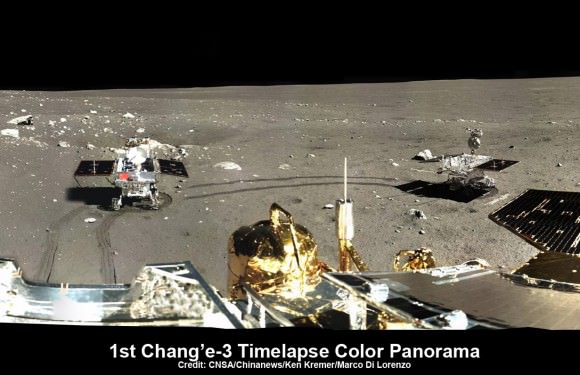
Yutu, which translates as ‘Jade Rabbit’ is named after the rabbit in Chinese mythology that lives on the Moon as a pet of the Moon goddess Chang’e.
The piggybacked pair of Chinese probes safely touched down on the Moon at Mare Imbrium near the Bay of Rainbows on Dec. 14, 2013.
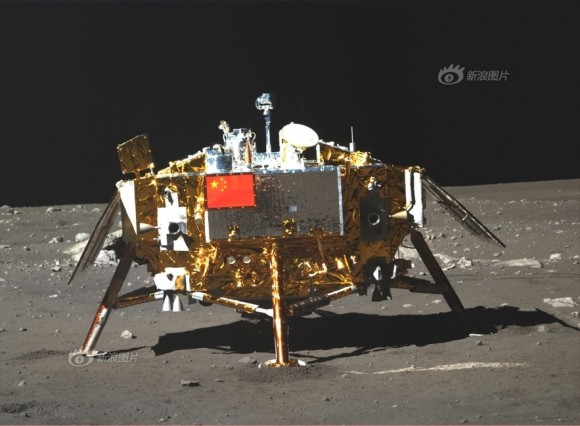
Apparently one of Yutu’s solar panels did not fold back properly over the instrument laden mast after it was lowered to a horizontal position into a warmed electronics box where it is shielded and insulated from the extremely frigid lunar night time temperatures.
Dust accumulation on the rover and gears may possibly be to blame for the failure to retract, based on unofficial accounts.
China has not released any official or detailed information on the cause of the malfunction or recovery actions taken by Chinese space engineers.
Such a malfunction could spell doom for the fragile electronic and computer components in the unprotected mast mounted instruments and systems, including the color and navigation cameras and the high gain antenna.
During each 14 Earth-day long night, the Moon’s temperatures plunge dramatically to below minus 180 Celsius, or minus 292 degrees Fahrenheit.
‘Jade Rabbit’ had departed the landing site forever, and was journeying southwards as the incident occurred – about six weeks into its planned 3 month long moon roving expedition to investigate the moon’s surface composition and natural resources.
The 140 kg Yutu robot drove off a pair of ramps and onto the moon seven hours after the Dec. 14, 2013 touchdown.
The 1200 kg stationary lander is expected to return science data about the Moon and telescopic observations of the Earth and celestial objects for at least one year.
Chang’e-3 and Yutu landed on a thick deposit of volcanic material.
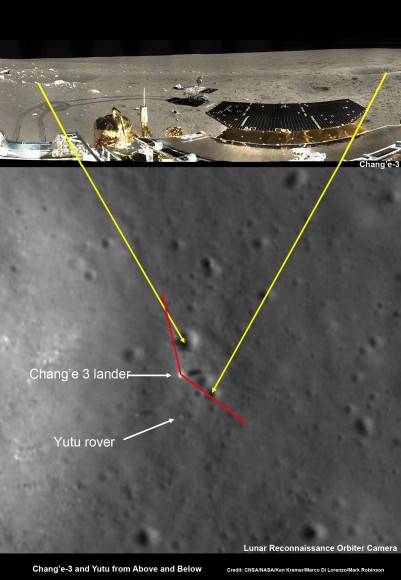
Composite view shows China’s Chang’e-3 lander and Yutu rover from Above And Below (orbit and surface) – lander color panorama (top) and orbital view from NASA’s LRO orbiter (bottom). Chang’e-3 lander color panorama shows Yutu rover after it drove down the ramp to the moon’s surface and began driving around the landers right side to the south. Yellow lines connect craters seen in the lander panorama and the LROC image from LRO (taken at a later date after the rover had moved), red lines indicate approximate field of view of the lander panorama. Credit: CNSA/NASA/Ken Kremer/Marco Di Lorenzo/Mark Robinson
They were designed to conduct their science investigations and work independently of one another.
China can be proud of its magnificent space flight accomplishment.
Chang’e-3 was the first spacecraft from Earth to soft land on the Moon in nearly four decades since the touchdown of the Soviet Union’s Luna 24 sample return spacecraft back in 1976.
America’s last visit to the Moon’s surface occurred with the manned Apollo 17 landing mission – crewed by astronauts Gene Cernan and Harrison ‘Jack’ Schmitt , who coincidentally ascended from the lunar soil on Dec. 14, 1972 – exactly 41 years before Chang’e-3.
China’s follow on Chang’e-4 Moon lander is due to blastoff in 2015.
Surely the science and engineering team will incorporate valuable lessons learned.
China is only the 3rd country in the world to successfully soft land a spacecraft on Earth’s nearest neighbor after the United States and the Soviet Union.
Stay tuned here for Ken’s continuing Chang’e-3, Orion, Orbital Sciences, SpaceX, commercial space, LADEE, Mars and more planetary and human spaceflight news.
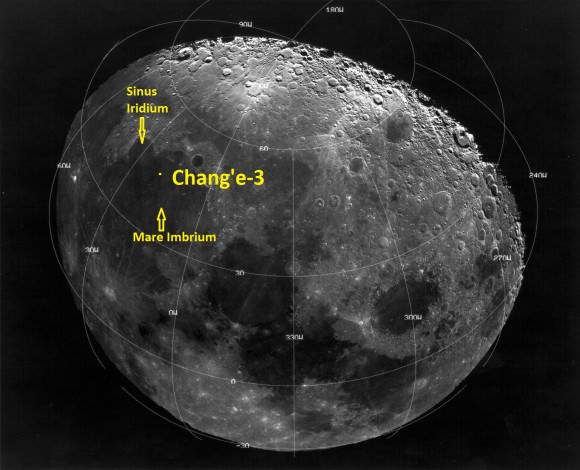

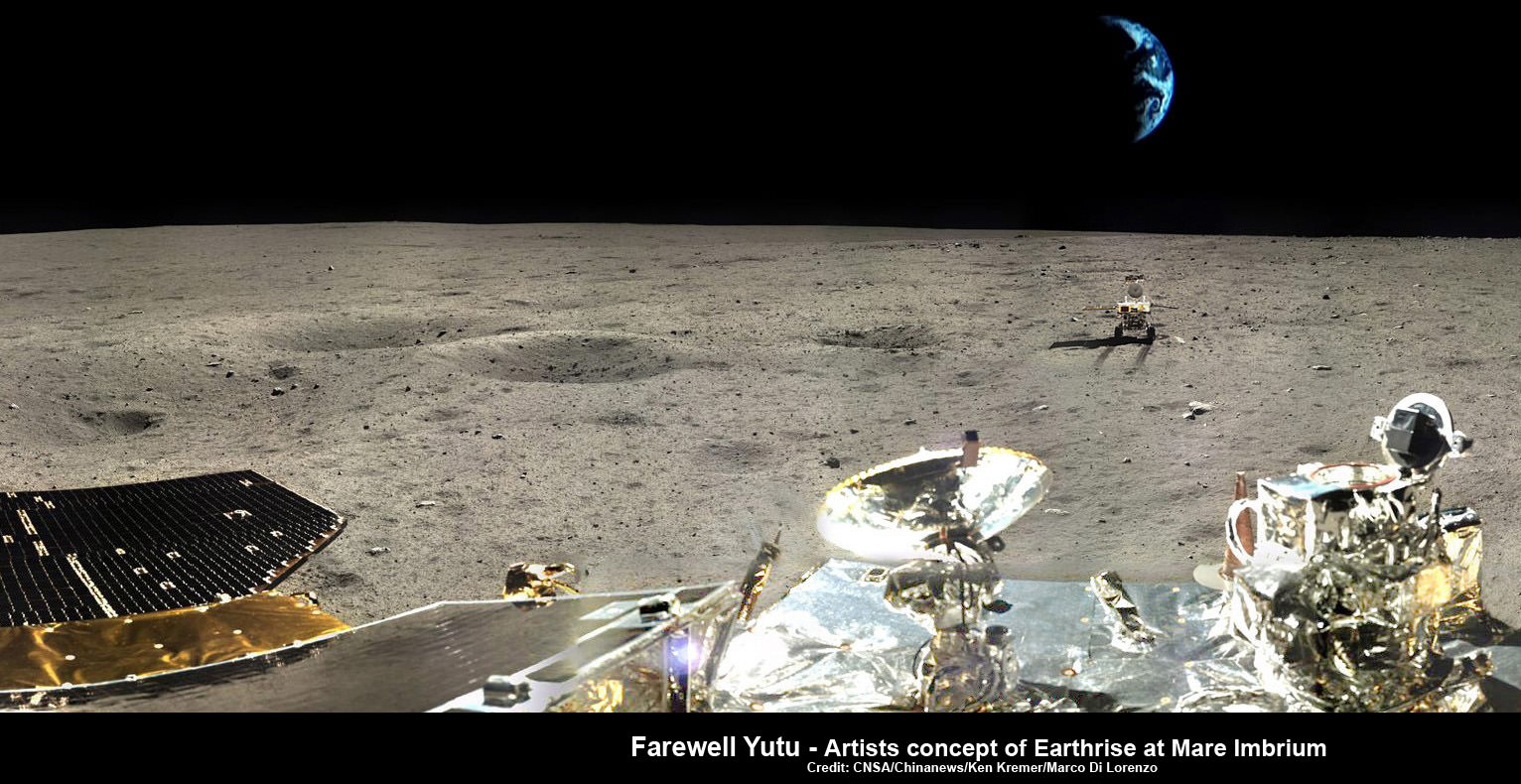
wups. They will get there. Excellent try China! Can’t wait to see whats next.
Nothing like another piece of junk on the moon!
Well… a dead ‘Wabbit’ died on the side of the road? Nothing new to see here folks.. move along. But the lander soldiers onward! Am wondering if the controllers actually knew something was up when they saw one of the solar panels had over-deployed? Then praps they decided to ‘drive off into the sunset’ to spare us images of the dead Wabbit?
Dag Nabbit they lost the Rabbit!
It’s very unfortunate this didn’t succeed. It’s about time we have a rover that explores this nearby world. Similar to what the Mars Rovers have done, I think we would deserve to have similar amazing viewpoints, but this time from our Moon 384000 kilometers away!
Thanks to Chinese guys… It was a good try…
As we have learned, the “Moon night” is really cold.
And, “reliability” of a spacecraft needs to be guarantied before launch…